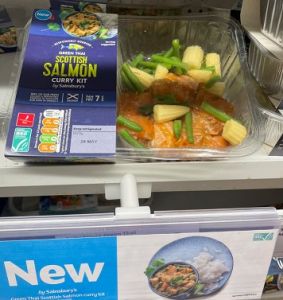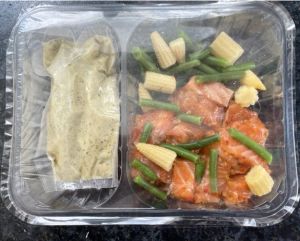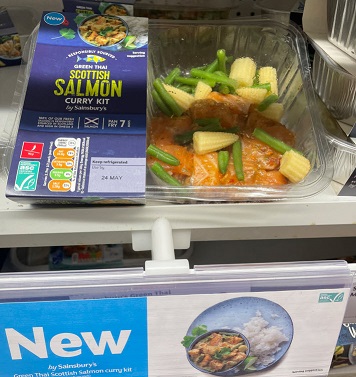Consumption: A couple of months ago, Seafood Source reported that seafood sales in UK grocery stores had declined by 8.3% for the quarter. Shortly after, Reuters reported that Britons are cutting back on fish. Surging prices are blamed but it is not just fish sales that have suffered as shoppers experience price rises across the board. Supermarket group Sainsbury’s have said that shoppers are now watching every penny.
Seafish have just published a 2022 update of seafood consumption https://www.seafish.org/document/?id=96643a00-bf15-4f14-982a-c769a2a01ee3. It does not make for happy reading. Seafish say that after ten years of decline, Covid provided a welcome boost to seafood consumption. Any improvement in retail sales however had to be offset by a massive hit on food service.
The expectation is that in the short-term seafood consumption in retail and food service will decline due to the current economic conditions as consumers trade down to save money and even out of the seafood sector altogether. Seafish are optimistic that consumers will return to chilled seafood as the market recovers. They say that this is what happened after the post financial crash of 2007/8, and they hope the same will happen now.
I am not so sure. The market now is very different to that of 14 years ago, especially relating to fresh and chilled fish. Whilst Seafish look at total fish and seafood consumption, I prefer to focus on just fresh and chilled fish. I believe that this is a better indicator of fish consumption than including ambient and frozen fish. Ambient is dominated by imported tuna and frozen is dominated by breaded and battered white fish. These are very different markets than natural fish.
Seafish say that by the end of December last year, UK retail consumption had returned to decline, although sales were still higher than pre-covid. For fresh and chilled fish, this decline actually began six months earlier in June 2021. After an initial 21.7% jump in April 2020, the next year was characterised by a continued monthly increase of an average 0.7% in volume. By comparison, the following year saw a 0.5% monthly fall in fish consumption with the decline increasing in size with every passing month. By March this year, the decline was 2.2%. I can only see this declining trend continuing, especially as Seafish have pulled the plug on any marketing effort. I never thought the marketing really addressed what the market needed so perhaps its loss will not be noticed. The decline in home consumption is inevitable.
However, in their update, Seafish do not consider what fish people are eating, just in what form. It doesn’t take much effort to see that home seafood consumption is changing. The traditional wild fish offerings appear to be those that are suffering most as farmed species dominate the shelves. Farmed salmon, sea bass, sea bream, and Basa as well as the ubiquitous warmwater prawns are those species that are likely to dominate home consumption in the years to come, whilst other species just fall by the wayside.
Market: Intrafish report that whilst Kavøy Fiskeoppdrett has had record sales so far this year, they are also concerned about the future. The company argues that the price has surged on lower volumes but as volumes return, they expect a market downturn. The company’s general manager Alf-Gøran Knutsen says that there is no market development, and this will be reflected in the market situation in the future. He also is concerned that if all the land-based farms start to offer the salmon they claim they will produce, this extra production will further undermine the price. The company also say that the higher income they have received must be offset against much higher production costs.
I first started talking about market development back in the early 1990s. In fact, the beginnings of reLAKSation resulted from comments I made about the salmon market then. I had written in an industry publication that perhaps the salmon farming industry should start to produce what the market wants rather than what the industry thinks the market wants.
At the time this statement was considered extremely contentious, and the ten salmon farmers representative association persuaded the publication to stop including my views and this led to the launch of reLAKSation as a vehicle for my views.
My meaning was that there is only a limited market for whole salmon but an infinite range of possibilities by adding value, initially by cutting up the fish and then only imagination can limit how salmon can be presented to the consumer. Despite the current high price of salmon, one of the newest products on the UK market is taste tested later in this issue of reLAKSation.
Meanwhile, the marketing organisations that do exist, tend to focus on origin, which in my view does little to expand the market. Instead, it makes producers feel good. At the same time, consumer surveys regularly show that origin is not a high priority for most consumers.
Salmon is undoubtedly a great success story and I firmly believe that production will never saturate the market, as long as product innovation continues. The alternative is to persuade consumers who never eat fish to start doing so. This cannot be done alone but requires governmental involvement and as yet, this seems highly unlikely.
Letchworth: The beginning of this month saw the end of a three-week campaign by the Norwegian Seafood Council in the small Hertfordshire town of Letchworth about forty miles north of London. The campaign – Sea Change – was to celebrate and promote sustainably sourced seafood from Norway. According to Fish Farmer magazine earlier this year, the campaign was intended as a test bed for new methods of marketing and communications in a bid to tempt more people to eat fish. How successful this was remains to be seen. I would imagine that the only measure of success is whether NSC repeat the campaign in other towns. I had intended to visit Letchworth and have a look for myself, but Covid rather limited my plans.
The NSC based themselves in a local shopping arcade for the duration and launched the campaign there using Michelin starred chef Simon Hulstone from the Elephant restaurant in Torquay to provide samples of tasty sustainable treats. There was also music games and a giant Mr Cod.
According to the local newspaper The Comet, other highlights of the campaign included promotions of fish and chips (£2.99 a portion) and local pubs serving sustainable seafood. In addition, two local primary schools held educational cookery lessons. Finally, families in and around Ridge Road were challenged to increase their weekly seafood consumption at home. This part of the campaign was fronted by TV chef Lisa Faulkner and nutritionist Juliette Kellowe.
Letchworth is a small town of over 30,000 people. It was the first ‘Garden City’ in the UK and was seen as an antidote to the overpopulation of the major cities. It was designed to be a green and pleasant place to live. It’s claim to fame is that it had the first road roundabout in the UK. It is now firmly placed in London commuter belt with a train journey of around 40 minutes. It is therefore relatively affluent however Letchworth also has four out of five of the most deprived areas in the administrative district of North Hertfordshire.
Whilst the focus on this town is novel and interesting, many of the NSC promotions are not. It is a case of wheel out the Michelin stared chef, but the reality is that Simon Hulstone is relatively unknown amongst even confirmed foodies. Promotions in fish and chip shops are also not novel and offering a portion of Norwegian cod and chips for £2,.99 is bound to attract the public. Whether they return to buy more when they have to pay £6.95 for the snack sized portion of cod and chips and just under £10 for a standard portion remains to be seen.
The idea to challenge families to change their seafood consumption habits is a good one. I don’t know whether there was any incentive to persuade them to do so but given that Letchworth does have areas of deprivation, the area selected for this part of the campaign seems rather prosperous and therefore is probably home to people who do already eat fish and seafood. I look forward to hearing the outcome when NSC publish the results.
A selection of photos from the campaign have been posted on the NSC twitter feed – @UK_NSC.
Finally, NSC took out a promotional advertorial in the local paper titled 6 reasons why sustainable seafood is good for you and the planet. I will just repeat the headings and not the short explanations here. The full article can be found at the Comet website – https://www.thecomet.net/things-to-do/food-reviews/the-benefits-of-eating-sustainable-seafood-9022032
- Our bodies can’t produce omega -3s
- Seafood can help meet the UK’s dietary needs
- Seafood is beneficial for your overall health
- Seafood has a low carbon footprint
- Sustainable fishing can allow stocks to recover
- The seafood industry is always improving
If I were reading the Letchworth Comet, I would have turned the page long before I got to number 2. If we want to get people to eat fish and seafood, we should not bore them into submission. We should be eating fish and seafood because it tastes great. Fish and seafood is not some health food that you buy from a health food shop; it should be just a part of our standard diet that we choose because it’s good to eat. Time will tell whether Letchworth residents decide whether it is or not.
Battered: The National Federation of Fish Friers have continued their campaign to raise awareness that fish and chip shops are under threat because of the high cost of fish due to sanctions on Russian cod and haddock. They claim many now face bankruptcy.
According to the Daily Mail about 30% of UK whitefish is imported from Russia, which probably says more about the UK fishing sector than it does about Russian fish.
Last month representatives of NFFF visited Norway to request Norway for more fish to keep prices under control. NFFF have asked for some fishing vessels to switch to fillet production for UK fish and chip shops.
I have discussed this issue in past issues of reLAKSation. I am not sure why fish and chip shops cannot use British landed whiting, coley etc instead of cod and haddock. Once the fish is deep fried, most consumers probably wouldn’t even notice the difference. This must be the best option for the UK fishing fleet and for fish and chip shops.
What is interesting now is that whilst NFFF have been lobbying the Norwegians in Alesund, the Norwegians, as discussed above, have been to Letchworth to promote sustainable Norwegian cod and chips for just £2.99. Perhaps the NFFF should be lobbying Norway to help with similar £2.99 promotions across all of the UK and not just in Letchworth.
Curry: Even though the high price of salmon makes adding value extremely difficult because the price of the finished product will exceed the price the consumer will be prepared to pay, there are still innovative ways that novel products can be developed and launched on the market.
Sainsbury’s have recently launched their infused ASC Scottish diced salmon with baby corn, green beans and Green Thai style curry sauce. The 365g pack sells at £4.50 but is currently on offer at £3.75.

This curry couldn’t be any easier to cook. The ingredients are pan fried for 5 to 6 minutes before the sauce is added and the whole mix cooked for a further minute. The finished dish was really tasty and made a filling meal for two when rice was added.


This is an excellent example of innovative dishes that can be made from salmon chunks cut from salmon flesh that is not necessarily the prime fillet.
For me where the product falls down has nothing to do with the fish or the recipe, but where Sainsbury’s chooses to display the pack. It is placed amongst the fish products and I believe that it has wider appeal and should be positioned with other ready to cook dishes based on other proteins. Consumers who already buy fish are probably more than capable of putting together a similar dish from a ready-made sauce and a few vegetables. The real attraction of this curry is that it should appeal to those looking for a Thai dish rather than one made from fish. Visiting the fish section is not necessarily the most obvious choice for such consumers.

